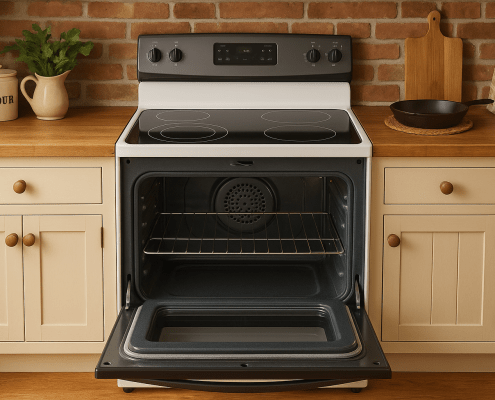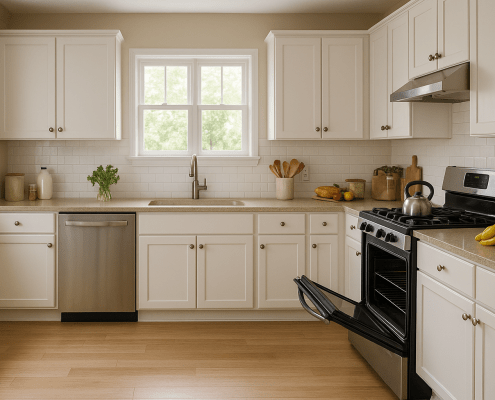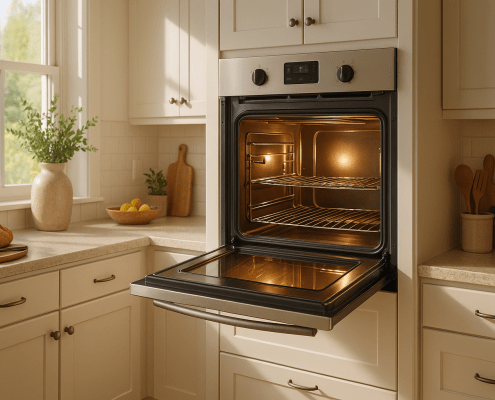Oven Door Won’t Open After Self Cleaning Cycle: Top 4 Reasons & Fixes (With Video!)
APP Expert / Wednesday July 6, 2022
Has your oven door ever locked shut after a self-cleaning cycle, leaving you frustrated and unable to cook your favorite meals? You’re not alone! This common issue can be solved with a quick DIY check-up, and our step-by-step guide will help you troubleshoot the most likely causes. Plus, don’t miss the informative how-to video just below for additional safety tips and a visual walkthrough!
Once you have identified the part needed for your oven, search below using your specific oven model number to identify the exact part needed:
Your oven’s self-cleaning function is a convenient feature with the potential to cause a lot of trouble for your appliance. If used too frequently or incorrectly, the high heat produced when the feature is running can cause damage to a number of components and lock your oven up tight. If your oven door is stuck shut after running the self-cleaning function, there are a few common issues that could have caused the problem. Luckily, all of these are easy for you to check yourself. With the right tools, you should have the problem diagnosed in an hour or so, and we’ll walk you through it!
Keep reading to find out how to troubleshoot an oven door that’s locked shut after a self-cleaning cycle, and don’t forget to check out the companion video below for some additional safety tips!
How Does The Self-Cleaning Function On An Oven Work?
Oven self-cleaning functions typically come in two types, but they both work roughly the same way: loosening up the baked on grime in your oven so that it can be easily wiped away. Self-cleaning ovens typically come in two styles:
- A high-heat cleaning system, where the oven raises the temperature of the interior to an intensely high heat – sometimes as high as 1000°F – and maintains it there for anywhere from fifteen minutes to a few hours. This incinerates any gunk on the walls or ceiling of your oven, leaving behind ash that’s easily wiped away. Damage to the oven is much more common with these types of self-cleaning systems.
- Steam-based cleaning is available on newer ovens. As the name implies, it heats water up to about 250°F, and uses the steam produced to loosen up grime stuck to the oven walls and floor. It’s safer and faster than high-heat cleaning, but somewhat less effective.
Want more information? Check out our guide to your oven’s self-cleaning function on our blog!
How To Troubleshoot A Stuck Oven Door
Tools for the job
You’re going to need a few things to do a full range of tests on your oven. Gather these items up before you begin:
- The appliance manual, which you can find a copy of online
- A multimeter, for checking continuity
- A pair of pliers
- A flathead screwdriver
- A Phillips screwdriver or nut driver, depending on the screws holding your oven’s rear access panel on.
- Work gloves
1. Start with the easy stuff: check the manual and reset the oven
Regardless of your oven’s brand and model, the door should stay locked until the heat inside has dissipated. As ovens reach an extremely high temperature when self-cleaning (up to 880°F, or 471°C, in some cases), for your safety, you should never try to force the oven door open before it has cooled down completely. Make sure you’ve given your oven sufficient time to cool off before trying to open a door – sometimes this can take several hours. If you’re still having issues and you know the oven is completely cool, you’ll want to reset your oven and reboot the control board:
- Unplug your oven for 5 minutes, then plug it back in.
- Reset the clock.
With your oven control board reset, the door should unlock. If you’re still having issues, there are a few other things you can try:
- Consult the manual. Every major appliance brand has their own specific steps for unlocking the oven door after a self-cleaning cycle – this is a pretty common problem to encounter, after all. If you no longer have a copy of your oven’s manual, it’s almost certainly still available online. Use your oven’s model number – found on a sticker on the appliance, usually either in the lower drawer or under the stovetop – to search for a copy online.
- Once you have a copy of the manual, follow the steps laid out there.
- It’s possible the range shut down mid-cycle and may need to complete a cycle before it will unlock. To fix this, you’ll have to run another cycle to completion.
- If your oven is displaying an error code, do not attempt to continue or restart the self-cleaning cycle. Consult your manual or the manufacturer’s website for a description of the error code for instructions on how to resolve the issue.
- Run the shortest cycle possible (anywhere from 15 minutes to 2 hours, be sure to consult your appliance manual).
- Allow the oven to cool down completely, then try to open the door again.
- If your oven has knobs, rather than digital input, make sure that the oven knob is still set to “CLEAN.” It may remain locked until you do this.
Before you proceed…
The next few items will involve checking and potentially replacing individual components within the oven. For safety, make sure the appliance is disconnected from power either at the wall outlet or circuit breaker before you proceed any further. Never perform maintenance on an appliance that is still receiving power, even if it’s turned off!
2. Inspect the door latch assembly
The door latch assembly on an oven, which holds the oven door closed, is a bit more complicated than the latches you’ll find on some other major appliances. It usually consists of a metal bar which acts as a locking catch for the door, a motor or lever that powers the latch, and a switch that reports whether the oven is opened or closed to the control board. All of this is contained within a metal housing.
Usually, the door latch can be found at the top of the oven door, just underneath the cooktop. Some styles split the latch from the motor and switch, putting the latch up front and the motor and switch in the back. The high heat generated by the self-cleaning cycle can potentially damage the door latch assembly. Most often, the switch or motor are melted or otherwise damaged, but occasionally, the latch itself or the bar connecting the two can be warped by the heat.
Here’s how to check this component:
- Access the door latch assembly. Depending on your oven, you may need to remove the rear access panel or lift up on the cooktop to reach the assembly. Consult your manual to determine what you need to do.
- Inspect the latch and bar for damage. If it’s bent or warped, you may be able to use a pair of pliers to bend them back into shape, but if it’s too far gone, you’ll need to replace the component. If the latch and bar are fine, it’s time to test the switch and motor.
- Grab your multimeter and set it to continuity, then touch the multimeter’s probes together to make sure it’s working.
- Test the switch.
- Remove the wires and connect a test probe to each terminal. At this point, it should not have continuity.
-
-
- Press the button on the switch with a flathead screwdriver. It should have continuity now.
- If the switch isn’t reporting continuity correctly, it has failed and needs to be replaced.
-
- Test the motor.
-
- Disconnect the wires from the motor terminals.
- Connect a test probe to each terminal. The motor should have continuity. If it doesn’t, the latch assembly will need to be replaced.
- Consult your manual! Many oven manuals will have a list of error codes and potentially even specific test procedures to test the latch.
3. Use diagnostic mode to check your oven’s control board
Time to take a look at the brains of the oven. The oven control board is a circuit board generally found in the middle of the range’s control panel. It utilizes data received from the oven’s sensors, switches, and user input to control the functions of the range.
When the control board fails – which can happen if the oven’s self-cleaning cycle is run too long or too frequently, again because of prolonged exposure to high heat – you will generally notice multiple issues with your oven. One of the problems you might encounter is a locked oven door; the control board will fail to power the latch when needed.
To test your control board, you’ll need to enter your appliance’s diagnostic mode and check for error codes. How this is done depends on your appliance’s brand and model number, but you can generally find full instructions on the tech sheet or in the range’s manual.
4. Test the oven temperature sensor
The oven temperature sensor measures the temperature within the oven and reports it to the oven’s control board. This, in turn, will determine how other components within the oven function. If your temperature sensor has failed, it may not report the correct internal temperature to the control board. In turn, the control board will believe the oven is still too hot and won’t release the latch.
While the sensor itself is found inside the oven, to test it, you’ll need access to the back of the range. Here’s what to do:
- Your oven should be room temperature when you do this. The oven temperature sensor is a resistor which reports a certain ohms reading based on the temperature of the oven. Refer to your oven’s tech sheet to see which temperature corresponds to which ohms reading.
- Set your multimeter to ohms. You’ll want to check what the proper ohm level is for your oven’s temperature sensor, as well.
- Gain access to the temperature sensor at the back of the range. You may need to remove a metal access panel on the back of your appliance to find it.
- Disconnect the temperature sensor, then touch a multimeter probe to each terminal. If the ohms reading is significantly off or doesn’t give a reading at all, the temperature sensor is bad and needs to be replaced.
Finding The Right Replacement Part
Have you tracked down the component that’s causing your oven door to stick? Great! Your next step is replacing that part. While that might seem a bit daunting, don’t fear! By testing each of these components out, you’ve already done half the work – replacing them often involves little more than disconnecting them, removing a few screws, and swapping old components out for new.
The hardest part, really, is finding the exact OEM part you need. Where do you start? With the appliance’s full model number. You can find that on a label somewhere on the appliance. Check the following places:
- Open the oven door and check around the frame.
- Open the broiler or range drawer and check along the sides or on the inside of the door, itself.
- Lift the cooktop and check beneath that.
- Check the exterior of the stove, it could be on the sides or back, behind the main control panel.
Once you have the model number, head over to AppliancePartsPros.com and type it in the search box. You’ll be presented with a list of genuine OEM replacement parts compatible with your appliance, and you can have the one you need shipped to you in just a few days!
Wrapping Up
With this guide, we’ve walked you through how to figure out what’s sticking in your oven door and directed you to the right part to fix the problem, but our help doesn’t stop there! If you need assistance with swapping out your oven parts – or parts for any major appliance – keep AppliancePartsPros.com in mind. Our friendly staff is on hand to answer your questions, and our site and YouTube channel are full of tips and tutorials for all your DIY appliance repair needs!
Stay connected with the latest DIY tips, tutorial videos, and repair guides by following us on Facebook, Instagram, and Twitter. We love hearing about your repair stories and successes. If you need more help or want personalized guidance, feel free to contact or call us at 877-477-7278. We’re ready to help you take on your next project with confidence!
Since 1999, AppliancePartsPros.com has helped millions of people repair their broken appliances by providing high-quality original parts at well below retail prices, free support and troubleshooting, and award-winning customer service from an expert, friendly, US-based customer support team!
Hi! I’m Matt H., and I’m thrilled to be your guide through the world of appliance repair with over 25 years of invaluable experience in the industry.
From the early days of my career, I have been deeply passionate about appliances and their inner workings. Over the years, I’ve seen it all – from vintage models to the latest cutting-edge technology – and I’ve dedicated myself to mastering the art of repair. With a toolbox in one hand and a wealth of knowledge in the other, I’ve tackled every challenge that has come my way, learning and growing with each repair.
Join me as we dive into the intricacies of appliance repair. From step-by-step repair guides to explanations of common problems and their solutions, I’ll be here to simplify the repair process and empower you with the knowledge you need to keep your appliances running smoothly.
Feel free to explore our blog, ask questions, and leave comments – this platform is a space for learning, sharing, and growing together. Let’s work together to ensure that your appliances continue to serve you for years to come.
Thank you for joining me on this journey, and I look forward to being your go-to resource for all things related to appliance repair!





